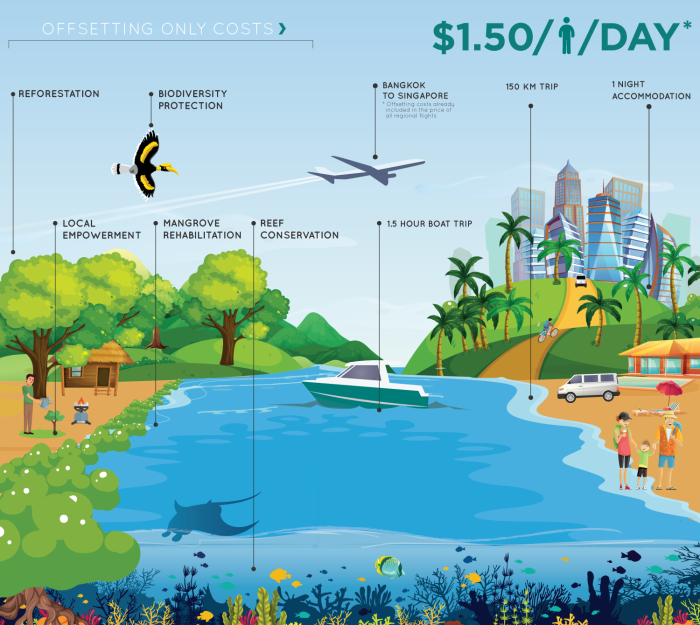
Carbon-neutral holiday destinations offer a sustainable way to travel while minimizing your carbon footprint. Discover popular eco-friendly travel spots and how they contribute to a greener future.
Learn about the initiatives and activities that make these destinations environmentally friendly and the benefits of choosing them for your next vacation.
Carbon-neutral holiday destinations
When it comes to traveling sustainably, choosing carbon-neutral holiday destinations is a great way to minimize your environmental impact. These destinations have taken steps to reduce or offset their carbon emissions, making them eco-friendly choices for your next vacation.
List of popular carbon-neutral holiday destinations:
- New Zealand: Known for its stunning landscapes and commitment to sustainability, New Zealand offers a range of carbon-neutral accommodations and eco-friendly activities.
- Costa Rica: This Central American gem is a leader in eco-tourism, with many hotels and tour operators focused on reducing their carbon footprint.
- Norway: With its focus on renewable energy and conservation, Norway is a top choice for travelers looking to explore the great outdoors in a sustainable way.
Concept of carbon neutrality in travel:
Carbon neutrality in travel refers to the balance between the carbon emissions produced by a trip and the carbon emissions removed from the atmosphere. This can be achieved through various means, such as investing in renewable energy projects, supporting reforestation efforts, or using carbon offset programs.
Benefits of choosing carbon-neutral holiday destinations:
- Reduced environmental impact: By choosing carbon-neutral destinations, you can help minimize your carbon footprint and support sustainable travel practices.
- Preservation of natural resources: Visiting destinations that prioritize carbon neutrality can help protect fragile ecosystems and wildlife habitats.
- Support for local communities: Many carbon-neutral holiday destinations are also committed to supporting local communities through eco-friendly initiatives, creating a positive impact beyond environmental conservation.
Activities/initiatives that make holiday destinations carbon-neutral:
- Energy-efficient accommodations: Many carbon-neutral destinations offer eco-friendly lodging options powered by renewable energy sources like solar or wind.
- Carbon offset programs: Some destinations partner with organizations that help offset the carbon emissions generated by travel activities, such as flights, by investing in carbon reduction projects.
- Eco-friendly transportation: From electric vehicle rentals to bike-sharing programs, carbon-neutral destinations promote sustainable transportation options to reduce emissions from travel.
Factors influencing carbon neutrality in holiday destinations
When it comes to achieving carbon neutrality in holiday destinations, several factors play a crucial role. Let’s delve into how transportation options, accommodation choices, local food sourcing, waste management, and community involvement impact the overall carbon footprint of a destination.
Transportation options
Transportation is a significant contributor to the carbon footprint of a holiday destination. Opting for eco-friendly modes of transport such as trains, electric vehicles, or bicycles can help reduce emissions and promote sustainability.
Accommodation choices
The type of accommodation chosen can greatly influence the carbon neutrality of a destination. Staying in eco-friendly hotels, lodges, or resorts that implement energy-saving practices and use renewable resources can make a significant difference in reducing carbon emissions.
Local food sourcing and waste management, Carbon-neutral holiday destinations
Supporting local food sourcing and practicing effective waste management are essential for achieving carbon-neutral practices in holiday destinations. By sourcing food locally, reducing food waste, and implementing recycling programs, destinations can minimize their environmental impact.
Community involvement
Engaging the local community in sustainability efforts is key to maintaining carbon-neutral holiday destinations. Encouraging residents to participate in conservation initiatives, supporting local businesses, and promoting eco-friendly practices can create a sense of ownership and responsibility towards environmental preservation.
Sustainable tourism practices

Sustainable tourism refers to practices that minimize the negative impacts of tourism on the environment, culture, and local communities, while promoting the conservation of natural resources and biodiversity.
Preservation of natural resources in travel spots
Preserving natural resources in popular travel destinations is crucial to maintain the ecological balance and protect the local flora and fauna. By implementing sustainable practices such as waste management, water conservation, and energy efficiency, these destinations can ensure long-term environmental sustainability.
Eco-friendly infrastructure and architecture
Eco-friendly infrastructure and architecture play a key role in promoting sustainability in tourism. Building hotels, resorts, and attractions with green technologies, renewable energy sources, and efficient design not only reduces carbon emissions but also sets a positive example for other establishments to follow.
Sustainable tourism certifications
- EarthCheck: A leading certification program that helps businesses in the tourism industry to monitor and reduce their environmental impact.
- Green Globe: Recognized worldwide, this certification promotes sustainability and social responsibility in the tourism sector.
- LEED (Leadership in Energy and Environmental Design): While not specific to tourism, this certification is widely used in the construction industry to ensure eco-friendly and sustainable building practices.
Impact of carbon neutrality on local communities

Implementing carbon-neutral practices in holiday destinations can have a positive impact on the livelihoods of local communities.
How Carbon-neutral practices positively affect local communities
- Reduced carbon emissions help to preserve the environment, ensuring a sustainable future for local residents.
- Improved air and water quality due to sustainable practices benefit the health and well-being of the community.
- Enhanced natural resources through conservation efforts can support local industries such as agriculture and fishing.
Economic benefits of promoting carbon-neutral tourism in developing regions
- Increased tourism revenue from eco-conscious travelers who are willing to support sustainable destinations.
- Creation of green jobs in renewable energy, conservation, and eco-tourism sectors, providing employment opportunities for locals.
- Boost in local businesses and markets as tourists engage in activities that promote sustainability and support community initiatives.
Education and awareness programs empowering local residents
- Training programs on sustainable practices can equip locals with the knowledge and skills to adopt eco-friendly habits.
- Raising awareness about the benefits of carbon neutrality can encourage community involvement in environmental protection efforts.
- Collaboration with schools, NGOs, and government agencies can help educate residents on the importance of sustainability.
Ways tourists can support local communities in carbon-neutral destinations
- Choose eco-friendly accommodations and tour operators that prioritize sustainability and support local initiatives.
- Participate in community-based tourism activities to directly contribute to the livelihoods of local residents.
- Respect local customs and traditions, and engage with residents in a culturally sensitive manner during your visit.
INTEREST RATES

Interest rates play a crucial role in the world of finance, impacting both borrowing and saving decisions. They represent the cost of borrowing money or the return on investment for saving funds. Let’s delve deeper into the concept of interest rates and their influence on various financial transactions.
Factors Influencing Interest Rates
Interest rates set by financial institutions are influenced by a variety of factors. These include:
- Central Bank Policies: The monetary policies of central banks, such as the Federal Reserve in the US, can directly impact interest rates. For example, a central bank may raise interest rates to control inflation.
- Economic Conditions: The overall economic health of a country, including factors like GDP growth, unemployment rates, and inflation, can affect interest rates. Strong economic performance may lead to higher interest rates.
- Market Forces: Supply and demand dynamics in the financial markets can also influence interest rates. If there is high demand for loans, interest rates may rise.
- Inflation Expectations: Expectations about future inflation rates can impact interest rates. Lenders may increase rates to compensate for anticipated inflation eroding the value of money.
Impact of Interest Rate Changes
Changes in interest rates can have significant effects on both the economy and consumer behavior. For example:
- Economic Growth: Lower interest rates can stimulate borrowing and spending, leading to increased economic growth. Conversely, higher rates may slow down economic activity.
- Investment Decisions: Investors may adjust their investment strategies based on interest rate changes. Higher rates may make saving more attractive, while lower rates can incentivize borrowing for investments.
- Housing Market: Fluctuations in interest rates can impact the housing market, affecting mortgage rates and home affordability for buyers.
Types of Interest Rates
There are various types of interest rates used in financial transactions, including:
- Fixed Interest Rate: A set rate that remains unchanged throughout the loan term, providing predictability for borrowers.
- Variable Interest Rate: A rate that can fluctuate based on market conditions, potentially resulting in lower initial payments but higher risks for borrowers.
- Prime Rate: The interest rate that banks offer to their most creditworthy customers, often used as a benchmark for other rates.
- Annual Percentage Rate (APR): The total cost of borrowing, including fees and interest, expressed as a percentage.
In conclusion, opting for carbon-neutral holiday destinations not only allows you to enjoy a guilt-free vacation but also supports local communities and promotes eco-friendly practices in the travel industry. Make a difference with your travel choices today!
Commonly Asked Questions: Carbon-neutral Holiday Destinations
What are some popular carbon-neutral holiday destinations?
Some popular carbon-neutral holiday destinations include Costa Rica, Iceland, and Bhutan, known for their commitment to sustainability.
How do transportation options impact the carbon footprint of a holiday destination?
The mode of transportation chosen by travelers significantly affects the carbon emissions of a destination. Opting for eco-friendly transportation like trains or electric vehicles can reduce carbon footprint.
What is the role of community involvement in maintaining carbon-neutral holiday destinations?
Local community engagement is crucial in preserving the sustainability of carbon-neutral destinations. Community initiatives, waste management programs, and eco-friendly practices all contribute to maintaining a green environment.






